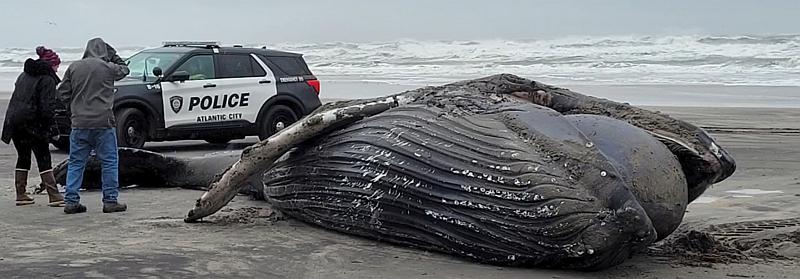 A recent article in the journal Oceanus, hosted by the Woods Hole Oceanographic Institution (WHOI), raises the question, “Are offshore wind farms harming whales?”
A recent article in the journal Oceanus, hosted by the Woods Hole Oceanographic Institution (WHOI), raises the question, “Are offshore wind farms harming whales?”
The short answer is “no.”
They write: A collection of seemingly grass-roots organizations claim that offshore wind projects are responsible for an uptick in whale deaths. But there’s no evidence to support their claims. Whales have been dying in larger numbers for many years, but offshore wind isn’t the reason why.
Many whale deaths go unreported because the animals don’t always wash up on shore. For those that do, a team of scientists is often quick to secure the carcass for a necropsy, which can help determine the cause of death. According to WHOI whale biologist Mark Baumgartner, offshore wind has never been found to be a contributing factor.
“Of all the right whales that have died over the last several decades,” he said, “the cause of death for juveniles and adults is always vessel strike or fishing gear entanglement.” That’s true for the critically endangered North Atlantic right whale as well as other whale species. Curiously, those causes of death aren’t mentioned in anti-wind save-the-whale campaigns.
Baumgartner’s views aligns with reports from the National Oceanic and Atmospheric Administration (NOAA) suggesting that there are no known links between large whale deaths and ongoing offshore wind activities. The East Coast is in the midst of a seven-year whale die-off that caused the agency to declare an Unusual Mortality Event (UME) for humpbacks in 2016 and for minke whales and North Atlantic right whales in 2017.
Large numbers of whale deaths happened before wind development efforts got underway. In 2017, people found 17 dead right whales—a huge number given their small population size. Most of these were found in the Gulf of Saint Lawrence, a place right whales historically visited only occasionally. Another significant die-off happened in 2019.
Those deaths were likely influenced by climate change, Baumgartner said. Scientists think “climate change was changing the distribution of their food.” Following their prey, the whales traveled farther north than they had before, into areas without protection. It wasn’t that people weren’t willing to protect them in these locations, simply that no one expected the whales to show up there. A major shipping channel coupled with lobster and snow crab fisheries were lethal threats to the whales.
“It’s no surprise that [the deaths] happened, but we just weren’t ready for that, at all. So we didn’t have conservation measures in place,” Baumgartner said.
Right whales have continued to visit the Gulf, and protections have since been enacted, with clear benefits to the whales.
While not addressed directly in the Oceanus article, a recent study by the Climate and Development Lab at Brown University documents that what Oceanus refers to as “seemingly grass-roots organizations” are in many cases backed by “fossil fuel interests working with climate denial think tanks to support new community groups in efforts to obstruct offshore wind projects. Though they appear to operate organically and independently, these groups often share legal support, personnel, talking points, tactics and financial resources with organizations that have been blocking climate policy for decades.”
In other words, many of the so-called “grass-roots” groups are “astroturf.”
Offshore wind can pose potential risks to whales. The biggest risks, according to Baumgartner, are vessel strikes or fishing gear entanglement. Nevertheless, increased ship traffic associated with the wind farms, which could lead to ship strikes and increased ocean noise are both threats.
But Baumgartner is optimistic. The bigger issue facing the whales is climate change, he says. And installing wind farms will help mitigate a changing climate, which can only help the whales.
See also: What is Killing Whales Off New York & New Jersey Coasts? Is Offshore Wind to Blame?

The scientists blithely ignore the impact of a large amount of poisons encapsulated and sunk around the world in casements designed to last 50 years. That 50 years is long passed. One ship was sunk about 100 miles southwest of San Francisco – where not too long ago whales in distress were spotted. Those pushing environmental causes ignore what it takes to create and maintain these giant devices in corrosive conditions. They also ignore biochem war impact vis a vis these ships that were sunk. It is good to assemble ALL the facts before crusading.
Total Energies, and She’ll Oil Company are fossil fuel companies working on offshore wind projects
Off the the New Jersey coast, are these parties a part of this problem:
Oceanus refers to as “seemingly grass-roots organizations” are in many cases backed by “fossil fuel interests working with climate denial think tanks to support new community groups in efforts to obstruct offshore wind projects.
While vessel strikes, and fishing gear entanglements are the immediate, and final cause of whale deaths, I find it hard to believe that there are no underlying causes, diseases, or injuries that initiated the immediate and final cause of whale deaths..